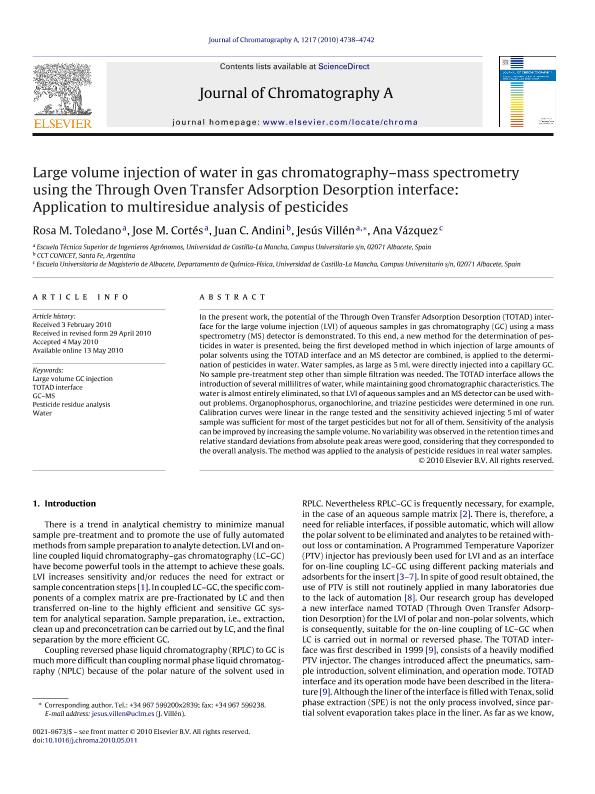Mostrar el registro sencillo del ítem
dc.contributor.author
Toledano, Rosa
dc.contributor.author
Cortés, José
dc.contributor.author
Andini, Juan Carlos

dc.contributor.author
Villén, Jesús
dc.contributor.author
Vázquez, Ana
dc.date.available
2017-02-20T21:53:40Z
dc.date.issued
2010-05
dc.identifier.citation
Toledano, Rosa; Cortés, José; Andini, Juan Carlos; Villén, Jesús; Vázquez, Ana; Largevolumeinjection of water in gaschromatography–massspectrometry using the Through Oven TransferAdsorptionDesorption interface: Application to multiresidueanalysis of pesticides; Elsevier Science; Journal Of Chromatography - A; 1217; 28; 5-2010; 4738-4742
dc.identifier.issn
0021-9673
dc.identifier.uri
http://hdl.handle.net/11336/13226
dc.description.abstract
In the present work, the potential of the Through Oven Transfer Adsorption Desorption (TOTAD) interface for the large volume injection (LVI) of aqueous samples in gas chromatography (GC) using a mass spectrometry (MS) detector is demonstrated. To this end, a new method for the determination of pesticides in water is presented, being the first developed method in which injection of large amounts of polar solvents using the TOTAD interface and an MS detector are combined, is applied to the determination of pesticides in water. Water samples, as large as 5 ml, were directly injected into a capillary GC. No sample pre-treatment step other than simple filtration was needed. The TOTAD interface allows the introduction of several millilitres of water, while maintaining good chromatographic characteristics. The water is almost entirely eliminated, so that LVI of aqueous samples and an MS detector can be used without problems. Organophosphorus, organochlorine, and triazine pesticides were determined in one run. Calibration curves were linear in the range tested and the sensitivity achieved injecting 5 ml of water sample was sufficient for most of the target pesticides but not for all of them. Sensitivity of the analysis can be improved by increasing the sample volume. No variability was observed in the retention times and relative standard deviations from absolute peak areas were good, considering that they corresponded to the overall analysis. The method was applied to the analysis of pesticide residues in real water samples.
dc.format
application/pdf
dc.language.iso
eng
dc.publisher
Elsevier Science

dc.rights
info:eu-repo/semantics/openAccess
dc.rights.uri
https://creativecommons.org/licenses/by-nc-nd/2.5/ar/
dc.subject
Large Volume Gc Injection
dc.subject
Totad
dc.subject
Interface Gcms
dc.subject
Pesticide Residue Analysis
dc.subject
Water
dc.subject.classification
Química Analítica

dc.subject.classification
Ciencias Químicas

dc.subject.classification
CIENCIAS NATURALES Y EXACTAS

dc.title
Largevolumeinjection of water in gaschromatography–massspectrometry using the Through Oven TransferAdsorptionDesorption interface: Application to multiresidueanalysis of pesticides
dc.type
info:eu-repo/semantics/article
dc.type
info:ar-repo/semantics/artículo
dc.type
info:eu-repo/semantics/publishedVersion
dc.date.updated
2017-02-17T13:27:24Z
dc.journal.volume
1217
dc.journal.number
28
dc.journal.pagination
4738-4742
dc.journal.pais
Países Bajos

dc.journal.ciudad
Amsterdam
dc.description.fil
Fil: Toledano, Rosa. Universidad de Castilla-La Mancha; España
dc.description.fil
Fil: Cortés, José. Universidad de Castilla-La Mancha; España
dc.description.fil
Fil: Andini, Juan Carlos. Consejo Nacional de Investigaciones Científicas y Técnicas. Centro Científico Tecnológico Santa Fe. Instituto de Desarrollo Tecnológico para la Industria Química (i); Argentina
dc.description.fil
Fil: Villén, Jesús. Universidad de Castilla-La Mancha; España
dc.description.fil
Fil: Vázquez, Ana. Universidad de Castilla-La Mancha; España
dc.journal.title
Journal Of Chromatography - A

dc.relation.alternativeid
info:eu-repo/semantics/altIdentifier/doi/http://dx.doi.org/10.1016/j.chroma.2010.05.011
dc.relation.alternativeid
info:eu-repo/semantics/altIdentifier/url/http://www.sciencedirect.com/science/article/pii/S0021967310006370
Archivos asociados
